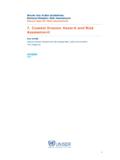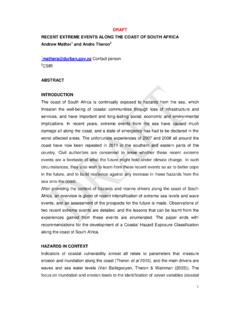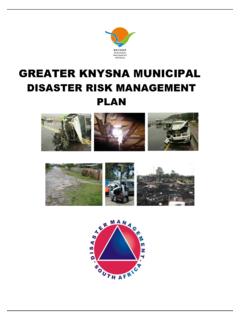Transcription of GCSE Geography Fieldwork examples Fieldwork toolkit
1 Fieldwork examples This resource is part of the Fieldwork toolkit that supports our GCSE Geography specification (8035) and sits alongside other resources in the Fieldwork ideas section. It is important to remember that content from one part of the specification may be applicable to another part and can be examined through Fieldwork in a location other than that specified. For example, there are tourism-related Fieldwork opportunities evident in , Glacial landscapes in the UK, but these concepts can also be examined in coastal or other locations. There are also opportunities to use content from parts of the specification at a different scale from that specified. For example, there are numerous urban field opportunities in , Urban issues and challenges, that can be investigated in urban areas that are not major cities within the UK. Schools can base the Fieldwork on the geographical concepts rather than the specified locations. Please refer to page 24 of the specification for the full Fieldwork requirements.
2 Some Fieldwork opportunities arising from the new specification Unit Ref. Unit Title Background Hypothesis/Question Concepts/Processes Data Collection Data Presentation Weather hazards an extreme weather event experienced in the UK. An opportunistic Fieldwork enquiry, as it can only take place when an extreme weather event occurs, eg great storm, drought, snowfall etc. Weather hazard X has had an impact on (area name). What impact did weather hazard X have on (area name)? Photographs of impacts. Questionnaires to local people to determine range and scale of impacts. Interview responses. Secondary data to Map of area with located photographs annotated to show impacts. Notes added to provide details. Economic impacts Environmental impacts Social impacts Management strategies Students would not investigate all of the above; one or two concepts may be the actual focus of the enquiry. confirm details of weather event. Climate change alternative energy production.
3 Could be carried out at local street level looking at the number of solar panels on houses within a locality. The local community in area X is helping to reduce the cause of climate change. How is the local community in area X helping to reduce the cause of climate change? Sustainable energy Renewable energy Using local street maps, record the number of solar panels evident on individual buildings. Interview people who have solar panels to see how much energy they generate. Locate results on a base map at street level; use proportional symbols to represent numbers of solar panels. Additional symbol(s) for energy data. GIS opportunity. Climate change changing agricultural systems. Could be carried out in a rural area or even on a city farm or market garden. Agriculture is changing to reduce the causes of climate change. How is agriculture changing to reduce the causes of climate change? Inputs (focus on changes) Interview with farmer to determine changes made recently, specifically aimed at reducing causes of climate change.
4 Secondary data provided by farmer and/or internet search. Map of farm annotated to show changes made. GIS opportunity. Graphs of changes to inputs, outputs, processes. Outputs (focus on changes) Processes (focus on changes) Climate change reducing risk from rising sea levels. Could be undertaken in a location where action has already been taken to reduce risk. It could also take place in an area at risk where plans are in place to reduce the risk of rising sea levels. Area X has responded to the risk of rising sea levels. How has area X responded to the risk of rising sea levels? Rising sea level Hard engineering Management Site visit, mapping and photographing strategies put in place (possibly evaluating these strategies). Secondary data re: flood risk, previous floods. Interviews with planners/residents. Mapping of strategies, with photographs and notes. Evaluation data added. GIS opportunity. Ecosystems small scale ecosystem. Could be a deciduous woodland, pond, heathland, hedge row.
5 The ecosystem at X is healthy and balanced. How healthy is the ecosystem at X? Ecosystem Producers Consumers Decomposers Quadrat sampling on land to determine features of ecosystem. Sampling by dipping in ponds. Recording species and numbers at site(s) used. Graphs of species numbers looking at ratios of producers to consumers to decomposers. coastal landscapes wave types and characteristics. Could be extended to look at coastal processes and landforms. Possible links to geology can be developed. The dominant waves at X are constructive (destructive). What types of waves occur at X? Wave counts at a range of locations. Measurements of wind speed and direction. Proportional arrows representing average wave frequency located onto a base map of the study area. Direction of arrow in line Constructive waves Destructive waves Any other coastal processes relevant to the location, eg longshore drift, erosion , deposition with prevailing wind. Wind strength can be shown with additional symbol or raw data added.
6 coastal landscapes mass movement and its impacts. Could be carried out along any section of coastline where mass movement is occurring and Fieldwork can be undertaken safely. Possible links to geology can be developed. Mass movement has had significant impacts on the coast at X. What impact has mass movement had on the coast at X? Mass movement Slumping Land use Photographs/sketches of mass movement. Measurement of cliff profiles heights and angles. Land use survey of area affected by mass movement. Annotated photographs or sketches of mass movement events. These can be located on a base map and/or geological map of location with land use identified to illustrate impact of cliff retreat. coastal landscapes erosion and its impacts. Could be carried out along any stretch of coastline where erosion is taking place and data collection can be carried out safely. Possible links to geology can be developed. erosion is changing the coastline at X. How is erosion changing the coastline at X?
7 Abrasion Attrition erosion Hydraulic action has not been identified as a key term as it is so difficult to measure in the field. Photograph or sketch evidence of erosion , eg undercutting of cliffs, landforms such as stacks and arches. Measure extent of wave-cut platforms. Measure changes in size of beach material. Annotated diagrams or photographs of erosional landforms, possibly with measurements added. Proportional symbols on maps to show changes in size of beach material. coastal landscapes longshore drift. Could be carried out along any beach where data collection can be carried out safely. Could be developed to include the study of landforms created by deposition. Longshore drift moves beach material North-South or West-East along the beach at X. In what direction does longshore drift move beach material at X? Longshore drift Constructive waves Destructive waves Fetch Use orange or tennis ball to measure distance of longshore drift in 2 minutes (or as long as you wish) along a stretch of beach.
8 Repeat as often as required. Measure drop in height to beach level either side of groynes if these are present. Count wave frequency at locations along the beach. Determine wind and wave direction. Use proportional arrows on base map of beach to show direction of longshore drift and distance covered by orange or tennis ball at each location used. Draw bars to show change in height either side of groynes and colour code based on side of groynes where data were collected. Add proportional arrows to the sea at each location to show wave frequency and direction. Add wind speed and direction using wind rose. GIS opportunities. coastal landscapes hard engineering and/or soft engineering and/or managed retreat. It is possible to look at just one of these strategies, or cover more if the opportunity arises. The coastal management strategy (strategies) at X is (are) effective. Is (Are) the coastal management strategy (strategies) at X effective? Hard engineering Soft engineering Managed retreat.
9 Take photographs and map strategies. Use EQS type of scoring system to assess effectiveness. Measure cliff profiles to assess stability. Look at vegetation coverage on cliff profiles to assess stability. Measure sediment Located photographs and graphs on base maps. Well annotated photographs of cliff profiles. Scale drawings of cliff profiles. Graphs of sediment accumulation at groynes. Possibly linked to: erosion Mass movement Longshore drift. accumulation at groynes to assess success in reducing longshore drift. Secondary data indicating rate of coastal change and need for management. GIS opportunities. River landscapes long profile. Changes along the long profile of a river need not involve using locations from source to mouth. Any sections of a river that are safe, accessible and show change over distance can be used. Changes in river features and/or characteristics and/or processes can be found over distance on the River X. What changes in river features and/or characteristics and/or processes can be found over distance on the River X?
10 Long profile Gradient Velocity Bedload Cross profile erosion Deposition There is no need to address all of these concepts/processes, just two Determine gradient from OS map evidence or in the field using clinometers. Velocity using floating object or hydroprop. Bedload size and/or shape, possibly using Powers Index. Width and depth for cross profile. Evidence of erosion bank undercutting, collapse, river cliffs, changes in bedload size and/or shape. Deposits of sediment mapped. Long profile drawn to scale for section(s) of river studied. Located graphs added to long profile to identify features/ characteristics. Cross profiles drawn to scale. Proportional symbols for bedload and velocity. Dispersion graphs for bedload. Scatter of bedload against velocity. would suffice. Possibly link to establish theories of rivers. River landscapes cross profile. Changes along the cross profile of a river need not involve using locations from source to mouth.
















